AMD Ryzen 7 8700G and Ryzen 5 8600G Review: Zen 4 APUs with RDNA3 Graphics
by Gavin Bonshor on January 29, 2024 9:00 AM EST- Posted in
- CPUs
- AMD
- APUs
- Phoenix
- 4nm
- Zen 4
- RDNA3
- AM5
- Ryzen 8000G
- Ryzen 7 8700G
- Ryzen 5 8600G
iGPU Gaming Performance: 1080p
There are limitations with integrated graphics, even those on the latest APUs, such as the AMD Ryzen 7 8700G with Radeon RDNA3-based graphics. That being said, we have tested our new suite of games for 2024 in this review, at least at 1080p on the integrated graphics. As we expand into 2024, we'll be benching all our CPUs on the new titles in our list, including the latest F1 2023, Returnal, the updated Cyberpunk 2077, and the demanding Company of Heroes 3 RTS.
We are using DDR5-5200 memory as per the JEDEC specifications on the Ryzen 7 8700G and Ryzen 5 8600G, as well as DDR4-3200 on the Ryzen 7 5700G and Ryzen 5 5600G. The same methodology is also used for the AMD Ryzen 7000 series and Intel's 14th, 13th, and 12th Gen processors. Below are the settings we have used for each platform:
- DDR5-5200 CL44 - Ryzen 8000G
- DDR4-3200 CL22 - Ryzen 5000G
- DDR5-5600B CL46 - Intel 14th & 13th Gen
- DDR5-5200 CL44 - Ryzen 7000
- DDR5-4800 (B) CL40 - Intel 12th Gen
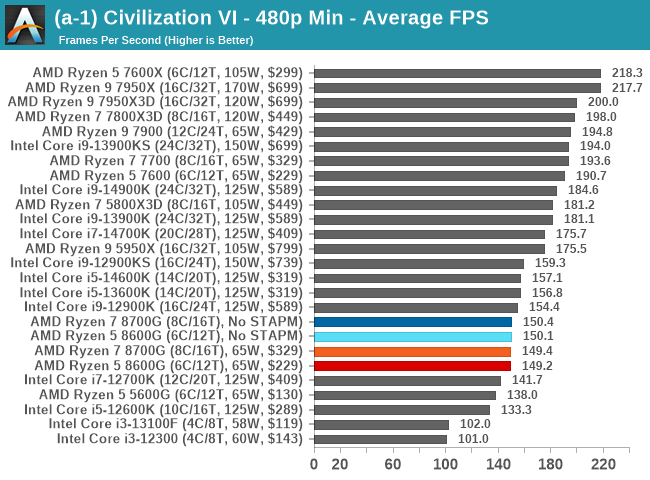
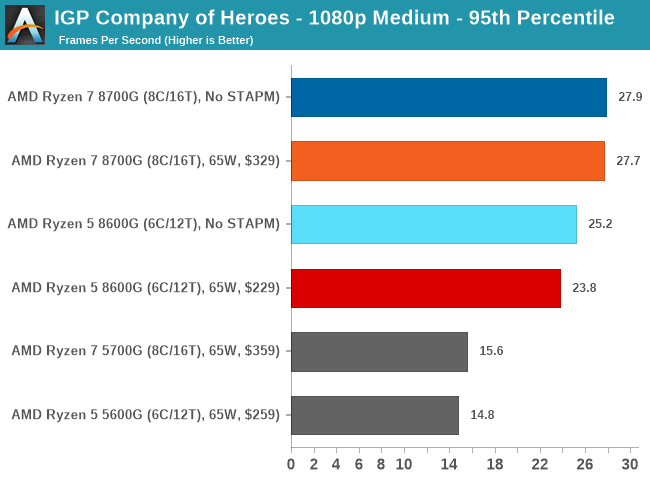
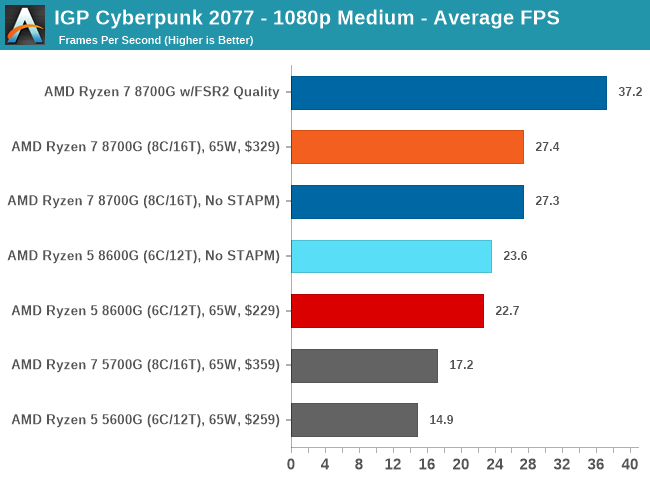

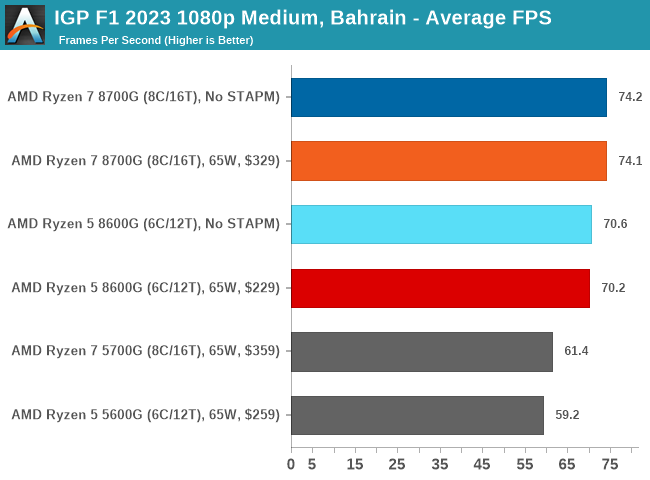

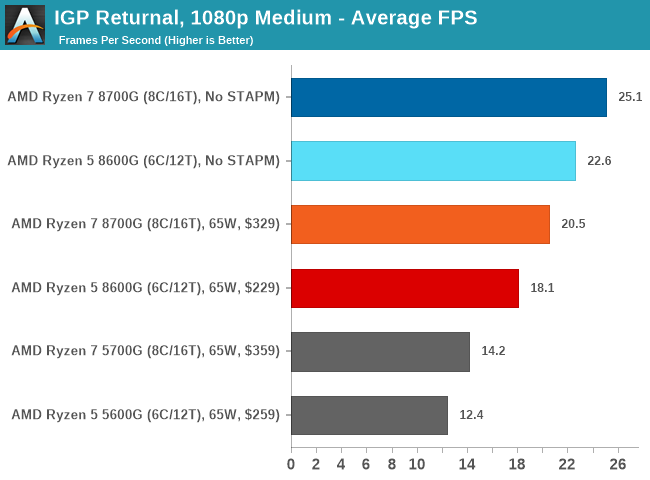
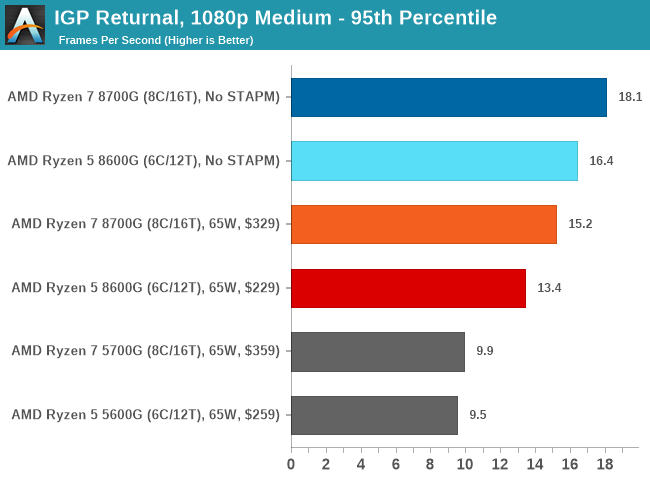
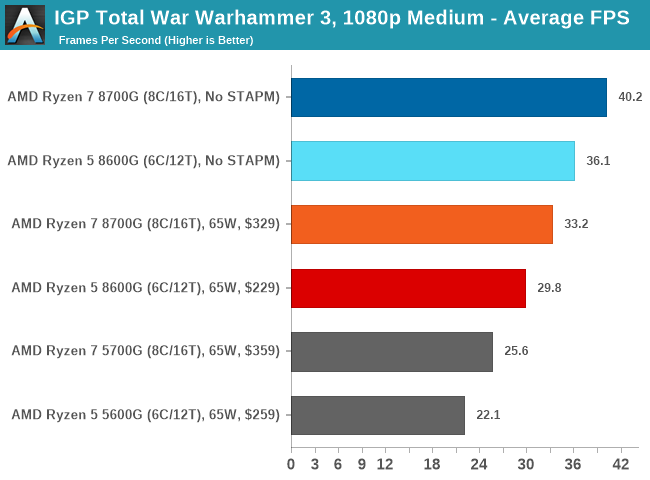

Using the new games in our test suite to compare performance between the Ryzen 8000G and Ryzen 5000G APUs, we can see a stark difference in gaming performance between the two generations of APUs. Firstly, the Ryzen 7 8700G is consistently ahead when using Medium settings at 1080p than the Ryzen 7 5700G, while the Ryzen 8600G is also comfortably ahead of both Ryzen 5000G APUs.
To add a little variation, we also tested Cyberpunk 2077 with AMD's FidelityFX image quality toolkit and saw fantastic performance. Not only did we see an uplift of around 37% in performance between the Ryzen 7 8700G and Ryzen 7 5700G, but with AMD FidelityFX applied, we saw an uplift of over 53%, which is impressive. Of course, not every game or title has FidelityFX, but applying it can certainly improve framerate performance with AMD's Ryzen 8000G series APUs.
Retesting the latest firmware, we can see that the Ryzen 7 8700G and Ryzen 5 8600G performance is marginally better at 1080p, just as we experienced at 720p on the Radeon 700M series integrated graphics. Gaming benchmarks are that they typically don't represent sustained loads, and we expect these performance figures to be sustained over longer periods of time with STAPM limitations removed.










111 Comments
View All Comments
t.s - Tuesday, January 30, 2024 - link
well, I care.goatfajitas - Tuesday, January 30, 2024 - link
I do see your point. You can put in some high end cooling and take advantage of the speed. That still doesnt fix the fact that it runs extremely hot and power hungry compared to its competition.ricebunny - Tuesday, January 30, 2024 - link
Highly dependent on application. In games they pull around 125W, roughly the same as high end Zen 4 CPUs.goatfajitas - Tuesday, January 30, 2024 - link
"Highly dependent on application. In games they pull around 125W, roughly the same as high end Zen 4 CPUs."Agreed on some setups. I have seen some equivalently equipped SFF/Tiny desktop setups (with obviously limited thermals) and Intel drops off alot earlier. The point being it runs too hot.
WaffleTech - Sunday, February 4, 2024 - link
"roughly the same"ComputerBase measured this over more than a dozen games and on average it's 149W for the 14900K and 72W for the 7950X3D, which is less than half. Even the Non-X3D 7950X with 105W uses almost 30% less in games.
Thunder 57 - Tuesday, January 30, 2024 - link
It's the enormous heat output that is the problem, not the electric bill.yankeeDDL - Thursday, February 1, 2024 - link
"no issue"? Are you joking?Cost aside, to dissipate 400+W you need massive cooling, and the MoBo needs to be way over-designed.
Intel peaks at 4x the power of Ryzen to, maybe, marginally beat it in few benchmarks. That's not irrelevant at all: this kind of delta in efficiency applies also on mobile (albeit not so extreme): that translates in battery life (and slower performance, as on laptops you can't peak at those levels).
is4u2p - Wednesday, January 31, 2024 - link
Was this in the 12th gen mobile CPUs?lakedude - Friday, February 9, 2024 - link
"Peak power is an irrelevant metric." maybe to you.Going AMD this time allowed me to save money on the cooler and the power supply. Gonna save money on electricity as well.
I hate the way Intel plays games with their TDP these days. Don't say something is 125w TDP if it can pull over 300w. Call it a 300w chip that can be underclocked or power capped to 125w. Or have it only pull 125w out of the box rather than leave it up to the user to fiddle around with turning it down.
wwenze - Monday, February 5, 2024 - link
Well, Intel definitely has the advantage when it comes to "not dying when pushed hard" or even "not dying when running at the actual stated specs" but outdate efficiency/IPC, while AMD is the opposite on both fronts.So Intel put the pieces together and said "what if we clock it until 250W turbo TDP while the competition only has 100W at that price point"